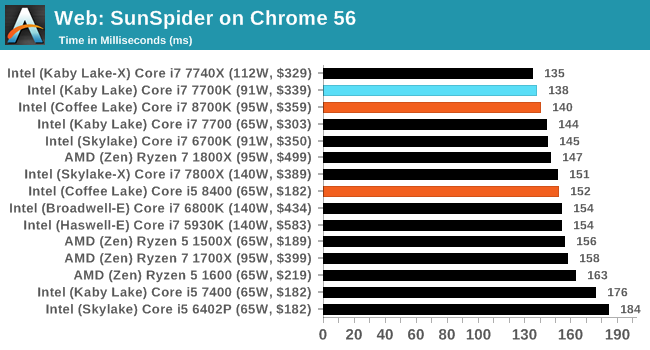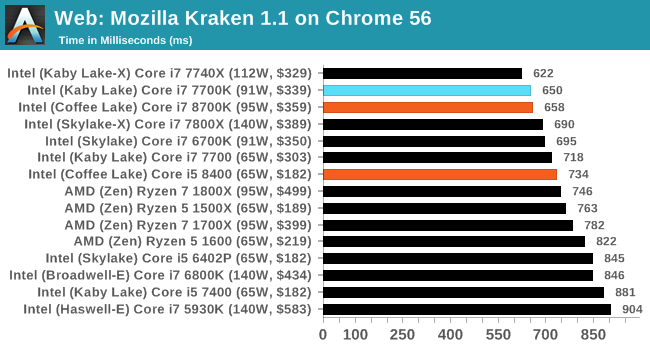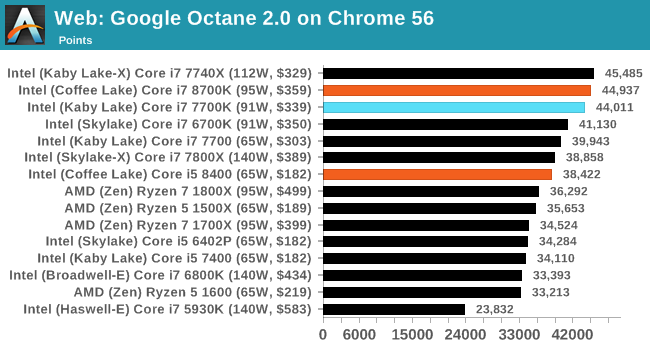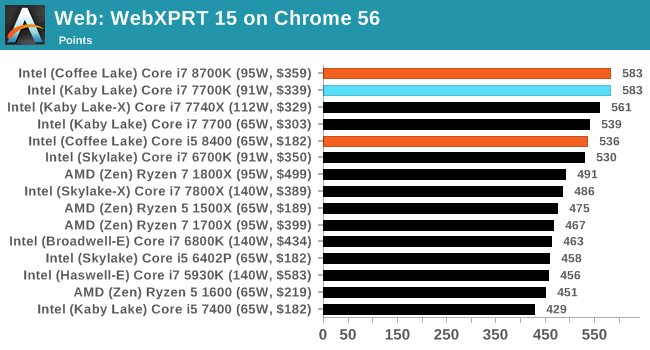The AnandTech Coffee Lake Review: Initial Numbers on the Core i7-8700K and Core i5-8400
by Ian Cutress on October 5, 2017 9:00 AM EST- Posted in
- CPUs
- Intel
- Core i5
- Core i7
- Core i3
- 14nm
- Coffee Lake
- 14++
- Hex-Core
- Hyperthreading
Benchmarking Performance: CPU Web Tests
One of the issues when running web-based tests is the nature of modern browsers to automatically install updates. This means any sustained period of benchmarking will invariably fall foul of the 'it's updated beyond the state of comparison' rule, especially when browsers will update if you give them half a second to think about it. Despite this, we were able to find a series of commands to create an un-updatable version of Chrome 56 for our 2017 test suite. While this means we might not be on the bleeding edge of the latest browser, it makes the scores between CPUs comparable.
All of our benchmark results can also be found in our benchmark engine, Bench.
SunSpider 1.0.2: link
The oldest web-based benchmark in this portion of our test is SunSpider. This is a very basic javascript algorithm tool, and ends up being more a measure of IPC and latency than anything else, with most high-performance CPUs scoring around about the same. The basic test is looped 10 times and the average taken. We run the basic test 4 times.

Mozilla Kraken 1.1: link
Kraken is another Javascript based benchmark, using the same test harness as SunSpider, but focusing on more stringent real-world use cases and libraries, such as audio processing and image filters. Again, the basic test is looped ten times, and we run the basic test four times.

Google Octane 2.0: link
Along with Mozilla, as Google is a major browser developer, having peak JS performance is typically a critical asset when comparing against the other OS developers. In the same way that SunSpider is a very early JS benchmark, and Kraken is a bit newer, Octane aims to be more relevant to real workloads, especially in power constrained devices such as smartphones and tablets.

WebXPRT 2015: link
While the previous three benchmarks do calculations in the background and represent a score, WebXPRT is designed to be a better interpretation of visual workloads that a professional user might have, such as browser based applications, graphing, image editing, sort/analysis, scientific analysis and financial tools.











222 Comments
View All Comments
masouth - Tuesday, October 10, 2017 - link
lol, he makes a comment on how SOFTWARE is written and you can't jump off YOUR bandwagon (be it Intel or Neutral) quick enough to heap your scorn.Dolpiz - Saturday, October 14, 2017 - link
https://youtu.be/oCSkyNHXIAE?t=20m48squanticchaos - Monday, February 5, 2018 - link
If you consider Ryzen does not have integrated graphics, Coffee lake beats its TDP hands down.Crono - Thursday, October 5, 2017 - link
I love the smell of coffee In The MorningIGTrading - Thursday, October 5, 2017 - link
We know that this is a "short" "pre-review", but it is a bit bizarre that there is no mention of AMD in the conclusion.Not that we consider that AMD should be necessarily mentioned in an article dedicated to an Intel launch, BUT Intel's offerings were always discussed in the conclusion section of every AMD review.
So we would consider it's just fair to remind people in the conclusion as well that the new Coffee Lake chips from Intel are a welcomed addition, but that they are unable to completely dethrone the competition and should be praised for the fact that AMD will be now forced to lower the Ryzen prices a bit.
The way it is right now, the conclusion is written like Intel is the only alternative, quad or hexa core, with nothing else on the market.
Personal opinion :
Despite me being the technical consultant on the team, this was observed by two of my colleagues (financial consultants) and they even brushed it away themselves as "nitpicking" .
Since I've worked in online media myself, this looks very similar with an attempt to post something to "play nice" with Intel's PR so we've decided to post this comment.
Therefore we eagerly await Ian's full review, with his widely appreciated comprehensive testing and comparisons.
Nevertheless, thank you Ian for your work! It is appreciated.
eddieobscurant - Thursday, October 5, 2017 - link
What did you expect, Anandtech is an intel pro review site. They didn't even mention the huge price difference between intel's z370 chipset motherboards required for coffee lake in contrast to amd's b350 chipset motherboards. It's almost double price.RDaneel - Thursday, October 5, 2017 - link
I haven't been following this closely, but does that mean that b350 boards are about $60? That's incredible! The Z370 I'm looking at is only $120, which didn't seem that bad, but if the b350s are really $60-70, then it might be worth checking out. Are they really that cheap?kpb321 - Thursday, October 5, 2017 - link
Yup. Newegg shows almost a dozen B350 boards for $60-$70 currently. Most are micro ATX but there are a couple ATX boards in that range currently (after rebate) including "gaming" boards like the MSI B350 TOMAHAWK.name99 - Thursday, October 5, 2017 - link
Really? Other times I've heard they are a pro Apple review site, a pro IBM review site, and a pro MS review site.They really seem remarkably catholic in whom they support.
seamonkey79 - Friday, October 6, 2017 - link
It depends on the article.